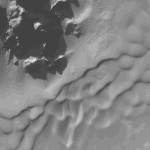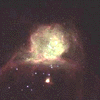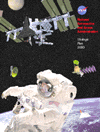|
[Space News]
[Gift Shop]
[Home]
| |
Space News...
Note: The links below will
open up in one new browser window. For best viewing, size the two web
browsers so that they don't take up the entire screen - this way, you will be
able to go back and forth to all the stories without losing your place.
Click
the Refresh button to
make sure you have the newest version.

|
 |
Mir de-orbited!
More Mars water evidence!
|

|
Ongoing coverage of Space Station Alpha at the International Space Station Mission Journal!

 | 31 January 2001 - Mars probe mission extended! NASA reports:
Successful Mars Spacecraft's Mission Extended
 NASA's
Mars Global Surveyor
spacecraft, which has collected more information about the Red Planet than
all previous missions combined, completed its primary science mission
yesterday and began a new era of continued exploration. Mars Global
Surveyor's extended mission--to continue its extraordinary mapping
capabilities to acquire data for the selection of future landing
sites--has been approved through April 2002. The robotic orbiter was
launched on Nov. 7, 1996, and arrived at Mars on Sept. 12, 1997. The
spacecraft began its primary mapping mission in March 1999 and has
collected data for a full Martian year, equivalent to about two Earth
years. Those comprehensive observations are proving invaluable to
understanding the seasonal changes on Mars. NASA's
Mars Global Surveyor
spacecraft, which has collected more information about the Red Planet than
all previous missions combined, completed its primary science mission
yesterday and began a new era of continued exploration. Mars Global
Surveyor's extended mission--to continue its extraordinary mapping
capabilities to acquire data for the selection of future landing
sites--has been approved through April 2002. The robotic orbiter was
launched on Nov. 7, 1996, and arrived at Mars on Sept. 12, 1997. The
spacecraft began its primary mapping mission in March 1999 and has
collected data for a full Martian year, equivalent to about two Earth
years. Those comprehensive observations are proving invaluable to
understanding the seasonal changes on Mars.
|
 | 28 January 2001 - It's been fifteen years since the
Challenger exploded. CNN's John Zarrella recalls the
day's tragic events. Where were you that day? Today In Space History - Today marks the 15th
anniversary of the biggest
tragedy in the history of the Space Program: The Challenger
disaster. On 28
January 1986, 7
astronauts lost their lives when Shuttle
Challenger exploded just 73
seconds after launch. Mission Fact sheet
here; Crew info
here;
Image collections here
and here.
Mission STS-51L
was the 25th
Shuttle flight, and it carried
the first "Teacher In Space",
Christa McAuliffe. The Challenger,
(OV-99),
was the second
orbiter built, and had completed
9 successful
missions (starting with STS-6
in 1983) before the terrible
incident, which was caused
by O-rings
in the right solid rocket
booster becoming brittle in the
winter cold. The
accident rocked
the nation and became embedded
in the minds of an entire
generation. The remains
of some crewmembers
were buried with honors at Arlington
National Cemetery, and the wreckage
of the spacecraft is sealed in a missile
silo at Cape
Canaveral. NASA grounded
the Shuttle program for more than two
years while safety
improvements were made. The Challenger
Learning Centers, dedicated to space science
education, were founded in
honor of the crew. Remember the
brave men and women of Challenger
and Apollo 1!
[Date: NASA]
|
 | 27 January 2001 - On the eve of the Challenger
anniversary, residents of Christa
McAuliffe's hometown reflect
quietly on the disaster which occurred fifteen years ago tomorrow. A Progress spacecraft, Russia's unmanned cargo ship, made a flawless
automated docking with the Mir space station, in preparation for its
destruction. Mir will be pushed out of orbit, and is scheduled to crash into
the Pacific ocean on March 6th.
Today In Space History - Today marks the 34th
anniversary of a tragic day in the race for the moon: the Apollo
1 fire. On 27
Jan 1967, three astronauts lost
their lives on the launch
pad at Cape Canaveral during a test
procedure in preparation
for what would have been the first
mission in the lunar
program. Gus
Grissom, Ed
White, and Roger
Chaffee perished when a spark
ignited the pure-oxygen
atmosphere of the Apollo Command
Module at Pad 34.
Details here
[requires free Adobe
Acrobat Reader]; Crew info here;
Image collections here
and here. The loss
of AS-204
caused a delay of nearly two years in the Apollo program, resulting in many changes
to the spacecraft design. In December 1997, nearly 31 years after the
accident, President Clinton awarded the Congressional
Space Medal of Honor to the fallen astronauts (their families
accepted the medals). Never forget the heroes
of space exploration!
[Date: NASA]
|
 | 04 January 2001 - The NEAR-Shoemaker probe orbiting
asteroid Eros is nearing the end of its
mission. NASA (in collaboration with Johns
Hopkins University) wants it to go out
with a bang by attempting
a landing on the 21-mile-long
rock. They cite the chances of success
at one percent (the spacecraft was not designed to
land), but they say that
the main goal is not the landing itself, but to get in close enough to take
super-detailed pictures before its fuel runs out. A lunar
eclipse will be visible
next week over Europe, Asia, and Africa. Stargazers in the northeastern
US and Canada may catch
the tail end of the celestial event.
You are here: An "X"-shaped gas cloud marks
the spot where a nearby
galaxy is forming new stars. The discovery was announced today be
scientists working on the Hubble Space
Telescope. NASA reports:
Hubble-X Marks the Spot of 'Nearby' Star Formation
 The
saying 'X' marks the spot holds true in this NASA Hubble
Space Telescope (HST) image where Hubble-X marks the location of a
dramatic burst of star formation, very much like the Orion Nebula in our
Milky Way galaxy, but on a vastly greater scale. Hubble-X sits in a glowing
gas cloud in one of the most active star-forming regions within galaxy NGC
6822, one of the Milky Way's closest neighbors. For more about Hubble X,
including fast facts, a comparison with the Orion Nebula, and information on
the astronomers studying it, click
here. Hubble-X was discovered by E. E. Barnard in 1881. Edwin P. Hubble,
after whom the HST is named, used the then-new 100-inch telescope at Mount
Wilson Observatory in 1925 to make the first detailed photographic
investigation of NGC 6822. The
saying 'X' marks the spot holds true in this NASA Hubble
Space Telescope (HST) image where Hubble-X marks the location of a
dramatic burst of star formation, very much like the Orion Nebula in our
Milky Way galaxy, but on a vastly greater scale. Hubble-X sits in a glowing
gas cloud in one of the most active star-forming regions within galaxy NGC
6822, one of the Milky Way's closest neighbors. For more about Hubble X,
including fast facts, a comparison with the Orion Nebula, and information on
the astronomers studying it, click
here. Hubble-X was discovered by E. E. Barnard in 1881. Edwin P. Hubble,
after whom the HST is named, used the then-new 100-inch telescope at Mount
Wilson Observatory in 1925 to make the first detailed photographic
investigation of NGC 6822.
More on investor Dennis Tito's planned trip to
Space Station Alpha.
Today In Space History - We're going waaaaay back for this one! It's been
391 years
(4 Jan 1610) since Italian astronomer
(inventor, artist, etc) Galileo
Galilei first used a telescope he built to observe our solar system. [Date: Catherin Gregory's Astro History]
More Space History - On 4 Jan 1958, Sputnik
I, the world's first artificial
satellite, re-entered the Earth's atmosphere and burned
up, after its short but historic mission.
Rumor has it that the launcher (a Soviet R-7
rocket) survived its re-entry and crashed
in Alaska in December 1957 - but no one's talking... [Date: United Space Alliance]
|
 | 03 January 2001 - The European
Space Agency is planning for a big
year in 2001. NASA has released a document (Adobe Acrobat file)
detailing their short- and long-term plans for space exploration. Their statement here:
Strategic Plan 2000 Charts NASA's Course
 NASA's
recently released Strategic Plan 2000 charts the agency's trajectory into
the frontiers of flight, space, and knowledge. It includes both near-term
priorities--flying the Space Shuttle safely and building the International
Space Station--and longer-term investments in America's future--developing
more affordable, reliable means of access to space and conducting
cutting-edge scientific and technological research. It describes our vision
for expanding air and space frontiers, serving America, and improving life on Earth. NASA's
recently released Strategic Plan 2000 charts the agency's trajectory into
the frontiers of flight, space, and knowledge. It includes both near-term
priorities--flying the Space Shuttle safely and building the International
Space Station--and longer-term investments in America's future--developing
more affordable, reliable means of access to space and conducting
cutting-edge scientific and technological research. It describes our vision
for expanding air and space frontiers, serving America, and improving life on Earth.
Arthur C.
Clarke has joined the thousands of people who will be sending
their DNA into space in a sort of time capsule, launching
in 2003.
More on the mysterious
monolith that appeared in a Seattle park [see yesterday].
Just in case you're not sick of comparisons to the "real" 2001
and the movie,
here's an article
from the BBC...
Today In Space History - Two years ago
today, (3 Jan 1999), the
ill-fated Mars Polar Lander (with its
two microprobes)
was launched
from Cape
Canaveral's Pad 17B, aboard
a Delta II rocket.
The spacecraft lifted
off successfully, but it was presumed lost
during its descent to the Martian surface.
[Source: NASA news]
|
 | 02 January 2001 - A steel
monolith mysteriously appeared in a Seattle park yesterday, prompting
comparisons to the one in the 1968 Stanley Kubrick
film.
No ape-like creatures or aliens were reported in the area, however. Shuttle Atlantis is due to launch on 19 Jan 2001, to deliver
the Station's newest module, the "Destiny" lab. Follow the flight
on our new STS-98 Mission Journal. Distant
galaxies being observed now may mean the universe is much older than previously thought.
Digital radio is on its way - beamed to your car or home via
satellite.
China may be gearing up for a second
unmanned test of their Shenzhou
spacecraft, capable of carrying astronauts (possibly 3 or 4) into
orbit!
More on Wednesday
morning's meteor shower (that's tonight,
depending on what time zone you're in). Shooting stars should also be
visible Thursday
morning.
Today In Space History - Today marks the
42nd anniversary (2
Jan 1959) of the launch of Luna
1, the first
man-made object to exceed escape
velocity and leave the Earth's orbit. The Soviet
space probe was designed
to crash-land on the lunar
surface, but missed
and went into a solar orbit instead (becoming, accidentally, the
first man-made object to orbit
the sun and to discover the solar wind).
[Date: The Last Frontier]
|
 | 01 January 2001 - Happy New Year!
Happy New Millennium!! (yeah, we know we were saying that last
year. Why celebrate once when you can celebrate twice?) President-elect Bush has picked Donald Rumsfeld to be his
Secretary of
Defense. He is in favor of militarizing
space - a very controversial issue.
Mir had another
minor glitch - and the date for its demise is set - February 27th-28th!
What are the
Quadrantids? No, it's not the latest boy band on MTV. They (it?) is a meteor
shower that comes around every January. Bundle up and check it out this
Wednesday night!
More on Cassini's
close approach to Jupiter.
What caused last week's crash of
a Ukrainian rocket
carrying six satellites for Russia's military? It may have been
a software glitch.
Today In Space History - It is the 200th anniversary of the
discovery of
Ceres, the
first, and largest, known
asteroid. On
1 Jan
1801,
Italian astronomer Giuseppe Piazzi
observed asteroid
Ceres. Thousands have been
discovered
since, mostly circling the Sun
between the orbits of
Mars and
Jupiter.
[Date: Catherin Gregory's Astro History]
More Space History - Seventy-six
years ago today (1 Jan
1925), American astronomer Edwin Hubble (yes,
the guy
they named HST after) announced that he had observed
nebulae outside of our own
galaxy, which made people
start believing that there is a universe beyond the Milky
Way.
[Date: Catherin Gregory's Astro History]
|
To keep going back in the timeline, check the Space News Archive for
December 2000,
November 2000,
October 2000,
September 2000,
August 2000,
July 2000,
June 2000,
Apr - May 2000,
Jan - Feb 2000,
Oct - Dec 1999,
and before.

[Top of the News]
[ISS News]
[STS-97 News]
[Photos]
[Gift Shop]
[Space Home]
|
